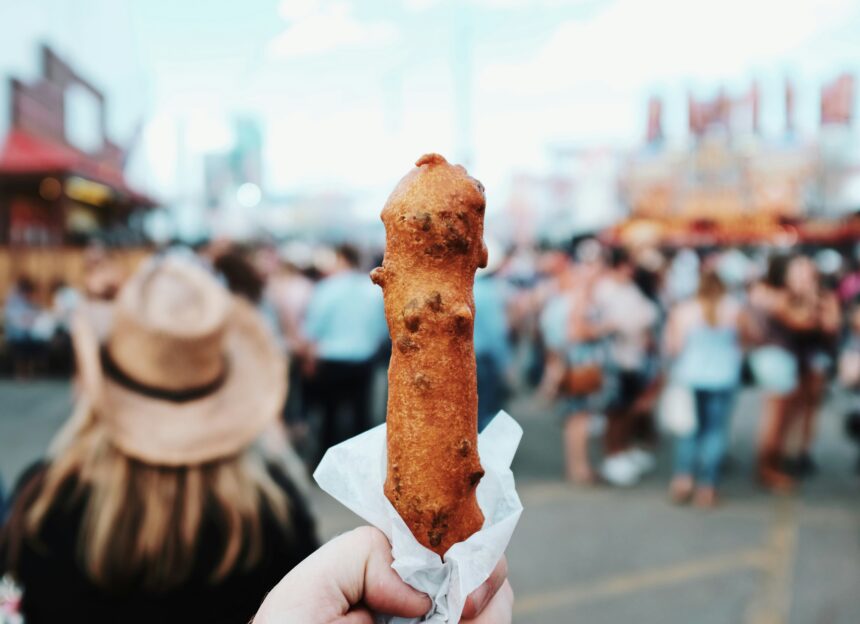If you think you know all there is to know about everyone’s favorite carnival snack, think again! The humble corn dog, with its golden coating and juicy hot dog at the center, is a staple of fairgrounds and fast-food chains worldwide. But beyond its delightful taste and convenient “on-a-stick” design, there’s an intriguing history and a myriad of fun facts that make the corn dog a more compelling subject than you might expect. Stay tuned as we explore the batter-coated world of corn dogs and the quirky stories behind them.
Corn Dogs and the State Fair Connection
One fascinating aspect of corn dog history is its deep-rooted association with state fairs, particularly the Texas State Fair, where it is believed to have made its grand debut in the early 1940s. This fairground favorite didn’t just capture the hearts and stomachs of Americans by accident; its popularity soared due to the perfect combination of portability, ease of eating without utensils, and delicious taste. Amidst the buzz and excitement of rides and games, the corn dog became a symbol of American ingenuity and the joy of state fairs. The celebration of National Corn Dog Day each March further cements its status as a cultural icon, giving enthusiasts a dedicated day to honor this deep-fried delight with deals, gatherings, and, of course, plenty of corn dogs. So, the next time you bite into a corn dog, remember its humble origins and be thankful for its timeless appeal.
The Science of Batter
The crispy outer layer of a corn dog is created by dipping a hot dog on a stick into a thick, cornmeal-based batter and then quickly deep-frying it. The trick to that perfect batter is its chemical composition and the science behind it. The batter, in terms of food chemistry, is a form of thin-layer battering. This mixing method ensures the cornmeal sticks to the hot dog, creating a barrier that helps keep the hot dog moist while protecting it from the hot oil.
When the batter is submerged in the hot oil, the water in the batter and hot dog begin to vaporize immediately. This generates steam that causes the batter to puff up and provides the crisp texture we all love. The color of the final product is enhanced by the Maillard reaction, a chemical reaction that gives browned food its distinctive flavor.
The Global Imprint of a Fair Food Icon
While the corn dog is a quintessentially American fair food, it’s interesting to note that versions of the corn dog can be found around the globe. In South Korea, for example, there’s a similar street food called “hotteok,” which is a pancake filled with sugar, honey, nuts, and sometimes other ingredients.
In Australia, the “dagwood dog,” which is a variation of the corn dog, is typically available at fairs. It consists of a frankfurter coated in an Australian cornmeal-based batter, deep-fried, and served on a stick.
Corn Dogs in Popular Culture
The corn dog has made a significant impact on popular culture. It has become more than a fairground staple; it’s a symbol of nostalgia, simplicity, and even humor. Corn dogs have found their way into movies, TV shows, and music. Who can forget the iconic scene in the movie “Legally Blonde” where Elle Woods deconstructs the legal phrasing of “alibi” because of a crucial misunderstanding over a corn dog?
In the children’s series “Diary of a Wimpy Kid,” the protagonist, Greg Heffley, struggles to win a corn dog-eating contest and cements the food as an emblem of determination. And, artists like Lorde have used the food metaphorically in their lyrics, underlining its cultural relevance.
The Nutritional Profile of Corn Dogs
While the corn dog might not be the first choice for those looking for a health kick, it’s interesting to explore its nutritional profile. A single corn dog provides around 220-250 calories, with fat being the highest contributor, followed by carbohydrates and protein.
Corn dogs are also a good source of vitamins and minerals. The hot dog in the center typically offers a mix of B vitamins and minerals such as iron, zinc, and potassium. While the cornmeal batter doesn’t offer many nutrients, it does provide some fiber, which can be beneficial for your digestive health.
The Vegan and Gluten-Free Revolution
The traditional corn dog is not suitable for those with certain dietary restrictions or preferences. However, there are now vegan and gluten-free versions available that cater to a wider audience. With plant-based hot dogs and alternative flours and grains, enjoying a corn dog is no longer off-limits to those who avoid animal products or gluten.
In fact, the challenge of creating a meat-flavored, non-meat hot dog is one that has intrigued food scientists for years. The rise of Impossible Foods and Beyond Meat has led to innovations that might soon offer a completely plant-based experience that replicates the taste and texture of a traditional corn dog.
The Quest for the Perfect Homemade Corn Dog
Die-hard corn dog fans often opt for the homemade version in pursuit of the perfect taste. The key to a great homemade corn dog is even more emphasis on the batter. It should be thick enough to coat the hot dog fully but still allow the hot dog to cook through. Achieving the right balance of cornmeal, flour, salt, and leavening agents is crucial to replicating the taste of a corn dog from the fair.
Food bloggers and home chefs often experiment with different batters, incorporating ingredients like honey for sweetness or buttermilk for tang. The cooking technique is also a point of debate, with options ranging from deep-frying to baking.
Corndog as an Innovator of Fair Cuisine
When talking about innovation, corn dogs are often left out of the conversation. However, they have been a significant part of changing tastes at fairs and festivals. The portable nature of the corn dog, with its convenient stick handle, makes it a stand-out example of how food can be designed for ease of consumption on the go.
Carnival and fair foods have a way of polarizing food enthusiasts and health gurus alike. But it’s hard to deny the allure and impact of the corn dog on the culture of food. Its distinctive taste and simple yet ingenious preparation make it a timeless choice for many.

From its origins in fairgrounds to its modern reinventions, the corn dog is a vibrant part of culinary heritage. Like many simple, classic foods, the joy of a corn dog is best understood through its shared experience. Whether you’re enjoying one at your local fair or trying out a homemade recipe, take a moment to savor the nostalgia and the science of this beloved treat.














